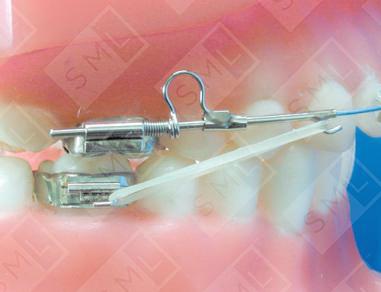Composed of maxillary and mandibular components, the 3D® Maxillary Bimetric Distalizing Arch produces rapid, bilateral or unilateral, friction-free distalization of the maxillary molars -- without the need for headgear (a real plus when treating young, appearance-sensitive patients). The maxillary components consist of a labial arch wire with an omega loop and a hook; anterior brackets; compressed coil spring; and molar bands. The set-up is as follows: The arch wire is ligated to the anterior brackets. Compressed coil spring is then placed on the labial wire between the adjustable omega stop and the buccal tube. The labial arch wire is then run through the buccal tubes of the molar bands. This set-up allows the coil spring to apply distal pressure on the molar while the omega stop allows for periodic reactivation of the spring as treatment progresses.
The mandibular component is a fixed lingual arch wire -- running from molar to molar -- which acts as an anchorage unit. It is extremely important to connect the maxillary arch wire to the lower anchorage unit. This ensures that the maxillary anteriors remain passive, while the molars are distalized...and it is easily done by attaching an elastic -- from the hook on the maxillary arch wire to the hook on the mandibular molar band. Elastics should remain in place at all times during active therapy.








